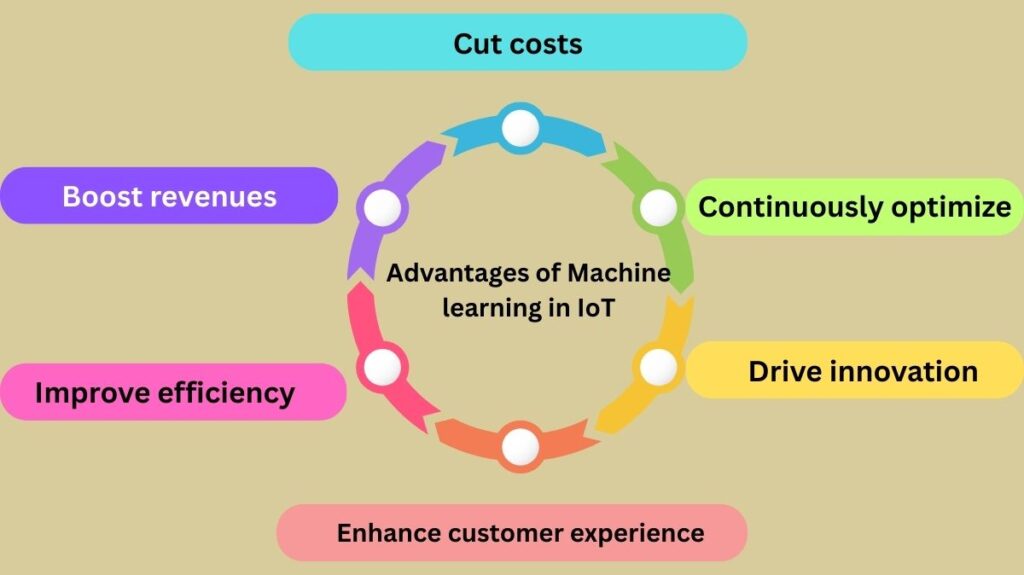What Is Machine Learning In IoT?
In the Internet of Things (IoT), machine learning (ML) integrates cognitive algorithms with connected devices to make data-driven decisions. It includes gathering and analyzing massive amounts of IoT sensor data to find trends and predict. ML enable IoT automation, predictive maintenance, anomaly detection, and personalization. Smart homes optimize energy utilization via ML, while industrial IoT monitors and predicts equipment failures. IoT and ML enable smarter, more adaptive, and more efficient systems, revolutionizing industries and daily life.

Understanding machine learning and IoT
Together, the Internet of Things (IoT) and machine learning (ML) enable your gadgets to learn and adjust to your needs in addition to connecting to the internet.
The large network of interconnected devices that collect and exchange environmental data via the Internet is known as the Internet of Things (IoT). Physical items can “talk” to one another in this digital world.
Without explicit programming, computers (and Internet of Things devices) can learn from data, spot patterns, and make predictions with machine learning (ML), a subset of artificial intelligence (AI). It is a strong data processor that can effectively rewire itself after learning from experience.
Advantages of Machine learning in IoT
Significant commercial value can be unlocked by combining machine learning and IoT. IoT gathers enormous volumes of data from the moment of deployment, which machine learning algorithms then turn into useful insights.
However, it is not a one-time benefit because machine learning models are always learning and improving. IoT data feeds back into ongoing operational efficiency by assisting machine learning models in becoming better over time. Businesses can ensure continued efficiency gains by using this feedback loop to automate more activities and optimize operations over time. ML and IoT can:

Cut costs
Early detection of faults by predictive maintenance minimizes costly repairs and equipment downtime. Automating repetitive tasks and maximizing worker use reduces operational costs.
Boost revenues
Develop fresh sources of income and enhance current ones.Real-time data and advanced analytics enable personalized products and services that increase customer satisfaction and revenue. Making well-informed, data-driven decisions that capitalize on new opportunities is made possible by an understanding of consumer behavior and market trends.
Improve efficiency
This combination of technologies is perfect for resource optimization and task or business process automation. IoT data is analyzed by ML algorithms to identify inefficiencies and provide fixes, increasing operational productivity.
Enhance customer experience
Start customizing customer experiences by leveraging insights from IoT data. IoT machine learning sheds light on consumer preferences and behavior. Customized products and tailored marketing become possible as a result, boosting client loyalty and satisfaction.
Drive innovation
Meeting market requests and resolving pain points is made simpler by machine learning and IoT data. Quickly changing course will help your company draw in new clients and solidify its position as a leader in technology.
Continuously optimize
ML models becoming more precise and efficient as IoT devices gather more data over time. Better insights can result in better company operations, which can then produce better data for even greater operational efficiency. This creates a positive feedback loop.
Use Cases for Machine Learning In IoT
Massive volumes of data are produced by IoT devices of various types as they continue to spread throughout industries. Machine learning techniques are becoming essential for gaining insightful information and streamlining processes. Using IIoT devices, companies can leverage machine learning algorithms to:
Automate data analysis
Bid farewell to manually crunching numbers! By automatically analyzing enormous volumes of sensor data, machine learning enables IIoT solutions to spot patterns, irregularities, and areas for improvement. The analysis process is streamlined by this automation, which also makes it possible to respond in real time and provides useful information for decision-making.
ML is used, for instance, in Siemens’ Senseye Predictive Maintenance and other predictive maintenance systems. They save downtime and expenses by analyzing sensor data from industrial equipment, forecasting when maintenance will be necessary, and scheduling maintenance actions appropriately.
Deliver predictive analytics
By examining past data from IIoT devices, machine learning models can spot trends that can be utilized to forecast future occurrences or actions. Machine learning algorithms can evaluate IoT data and predict future trends, enabling organizations to remain ahead of the curve in anything from equipment failure prediction to consumer demand forecasting.
Duke Energy’s use of ML in IIoT to forecast energy consumption trends based on weather data, customer usage trends, and other variables is a prime example. This enables them to expedite the company’s shift to sustainable energy while improving resource management and cutting expenses.
Enhance quality control
Real-time IIoT sensor data monitoring using machine learning can spot irregularities and possible problems before they become serious. Consistent quality in manufacturing and other industries is ensured by this industrial use of machine learning in the Internet of Things. Semiconductor manufacturers examine sensor data from their fabrication facilities using IoT and machine learning technologies to find abnormalities and production flaws before they have an impact on the quality of their products.
Monitor patterns across a network
System-wide data from IoT devices can be analyzed by machine learning to find trends in possible security risks like cyberattacks or unusual activity. ML system monitoring is used by many enterprises to improve the overall security posture of IoT networks. In order to identify and stop known malware or cyberthreats that target IoT devices, machine learning can also be trained in IoT security models.
Businesses like Cisco and IBM provide security solutions driven by machine learning (ML) that can examine network traffic patterns and spot possible dangers like distributed denial-of-service (DDoS) assaults. According to IBM, up to 85% of alerts can be “automatically escalated or closed, helping to accelerate security response timelines for clients.” It saves a significant amount of time and money.
Improve response time for time-critical applications
Insufficient connectivity? No issue. Even when not networked, machine learning-powered edge devices can react more quickly and function more effectively because they can evaluate data and make decisions locally. For time-sensitive applications like industrial automation systems or driverless cars, edge machine learning speeds up response times and eliminates the need for continuous cloud connectivity. A new era of intelligent real-time applications is made possible by the integration of machine learning in edge IoT devices.
Edge machine learning has a strong use in Dubai’s smart city projects. To interpret traffic camera footage, hundreds of edge AI boxes have been placed throughout the city. In the video streams, these edge AI devices automatically identify suspicious activity, traffic infractions, and road hazards. While managing data on the edge protects privacy by preventing careless video uploads, these devices aid authorities in responding to problems quickly. According to Dubai’s Roads and Transport Authority, the project has already resulted in a 63% improvement in incident monitoring, a 30% reduction in reaction times, and a 20% reduction in journey times.
Almost any industry might benefit from these IoT machine learning use cases. Projects involving data analysis, predictive analytics, quality control, network monitoring, and time-sensitive applications are found in many types of enterprises. Let’s examine some sectors that are utilizing machine learning and the Internet of Things at an early stage.
